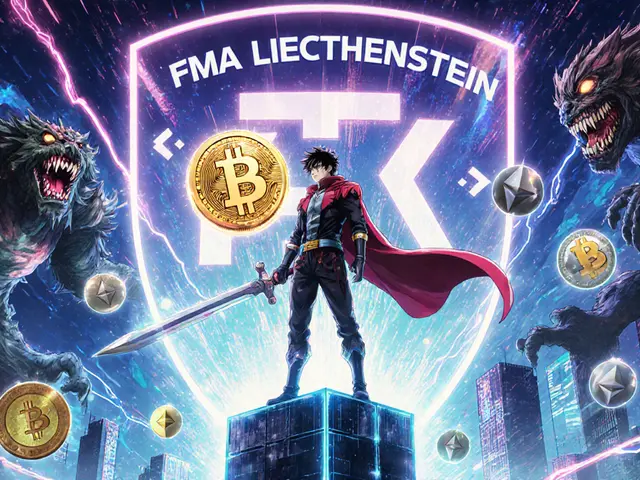Liquidity Pool Risk Calculator
Risk Assessment Results
Impermanent Loss
Smart Contract Risk
Market Volatility
Governance Risk
Gas Cost Sensitivity
Anyone intrigued by DeFi quickly learns that providing liquidity can feel like a shortcut to passive income. Yet behind the appealing fee‑share numbers lie a suite of hidden dangers that can turn a nice yield into a painful loss. This guide pulls back the curtain on the most common liquidity pool risks and shows exactly how you can protect your capital before you lock any tokens.
What Is a Liquidity Pool?
When you hear the term Liquidity pool is a smart contract that holds paired assets contributed by users, allowing traders to swap tokens without a traditional order book, you’re looking at the engine behind most decentralized exchanges (DEXs). The pool’s automated market maker (AMM) algorithm constantly rebalances the two assets so trades can happen at any time. Liquidity providers (LPs) earn a slice of every swap fee, but they also hand over full control of their funds to the contract.
Key Risk Categories
Liquidity provision isn’t a one‑size‑fits‑all activity. The risks fall into five broad buckets, each with its own technical triggers.
Impermanent Loss
Impermanent loss is a value divergence that occurs when the relative price of the two tokens in a pool moves away from the ratio at deposit time. Imagine you add equal USD values of ETH and USDC to a pool. If ETH spikes 50% while USDC stays flat, traders will sell the now‑expensive ETH into the pool, leaving you with more USDC and less ETH. When you finally withdraw, the combined USD value can be lower than if you’d simply held the assets outside the pool. The loss becomes permanent only if the price gap never closes.
Smart Contract Vulnerabilities
Every pool lives inside a Smart contract that executes the AMM logic autonomously and custody the deposited tokens. If that contract contains a bug or an unchecked function, hackers can siphon funds in seconds. High‑profile exploits-like the 2022 Wormhole bridge hack that stole $320M-show how a single line of faulty code can erase an entire liquidity vault. Audited contracts reduce risk, but no audit guarantees absolute safety.
Market Volatility & Out‑of‑Range Risks
Traditional pools rebalance automatically, but newer “concentrated liquidity” designs (e.g., Uniswap V3 is a protocol that lets LPs concentrate capital within a custom price range) require active management. If the market price drifts outside your chosen range, your liquidity stops earning fees and sits idle-sometimes for weeks. Re‑entering the range means paying gas fees, which can eat into any prospective profit.
Governance & Rug Pull Threats
Some projects retain centralized control over the pool’s governance parameters. When a malicious team or a compromised admin address can modify fee structures or withdraw assets, the whole pool is vulnerable. A classic Rug pull is a scam where developers drain liquidity after luring investors with a new token. They often pair the new token with a well‑known asset like ETH, attract large LP contributions, then sell the native token en‑masse, leaving liquidity providers with a worthless remainder.
Gas and Transaction Costs
Every interaction with a pool-deposit, withdraw, rebalance-requires a blockchain transaction. On busy networks, gas fees can spike to $50 or more per action. For LPs who need to adjust positions frequently (common with concentrated liquidity), these costs can erode the net APY dramatically, especially when fee revenue is modest.
How to Assess Your Exposure
Before you click ‘Add Liquidity’, run through this quick self‑check:
- Identify the token pair and verify both assets have robust market depth.
- Review the smart contract audit report; note any “high‑severity” findings.
- Calculate potential impermanent loss using a simple formula:
IL ≈ 2·√(P_new/P_old)/(1+P_new/P_old)−1, where P is the price ratio. - Check who controls the governance keys-look for timelocks or multi‑sig ownership.
- Estimate gas fees for your expected transaction frequency; add them to the fee‑share projection.
If any red flag appears, either walk away or look for a lower‑risk alternative.

Mitigation Strategies You Can Use Today
- Prefer stable‑coin pairs. A USDC/DAI pool experiences near‑zero impermanent loss while still generating fee income.
- Allocate a portion of your capital to Stablecoin pools that are backed by reputable custodians.
- Use platforms that lock liquidity for a set period (e.g., 30‑day lock) to reduce rug‑pull exposure.
- Set tight price‑range limits on concentrated liquidity and automate rebalancing with bots that trigger only when gas < $5.
- Diversify across multiple pools and protocols; don’t concentrate all assets in a single high‑yield pool.
- Monitor on‑chain analytics dashboards (e.g., Dune, Zapper) for sudden drops in TVL or abnormal token movements.
Comparing Risk Profiles of Common Pool Types
| Pool Type | Impermanent Loss | Smart‑Contract Risk | Governance / Rug Pull | Gas Cost Sensitivity |
|---|---|---|---|---|
| Stablecoin‑Stablecoin (USDC/DAI) | Very Low | Low (often audited) | Low (commonly community‑governed) | Low |
| Stable‑Crypto (USDC/ETH) | Medium (price spikes in crypto side) | Medium (depends on protocol) | Medium (some projects retain admin keys) | Medium |
| Crypto‑Crypto (ETH/BNB) | High (price divergence) | Medium‑High | Medium‑High | High |
| Concentrated Liquidity (Uniswap V3 ETH/USDC range) | Variable (depends on chosen range) | Medium | Low‑Medium (protocol‑wide governance) | High (frequent rebalancing) |
Practical Checklist Before Adding Liquidity
- ✅ Verify the pool’s contract address on an official source.
- ✅ Confirm the audit status and read the auditor’s summary.
- ✅ Compute expected impermanent loss for a 20% price move.
- ✅ Ensure the token team has locked at least 75% of the native token supply.
- ✅ Set a gas‑budget ceiling for any future rebalancing.
- ✅ Record your entry price, token ratio, and chosen price range (if applicable).
Cross‑checking each bullet dramatically reduces surprise losses.

Frequently Asked Questions
Frequently Asked Questions
What is the difference between impermanent loss and permanent loss?
Impermanent loss is unrealized; it only becomes permanent if you withdraw while the price gap remains. If the token prices later converge, the loss can shrink or disappear entirely.
How can I tell if a pool’s smart contract is safe?
Look for a reputable audit report (e.g., from Certik, Trail of Bits) and confirm the audit date is recent. Check community forums for any post‑audit bug disclosures. A multi‑sig treasury and timelocked upgrades are good signs.
Are stablecoin pools completely free of impermanent loss?
They have the lowest exposure because both assets track the same fiat peg. Small deviations can still occur if one stablecoin de‑pegs, but the risk is minimal compared to crypto‑crypto pairs.
What red flags indicate a potential rug pull?
Key warning signs include: the token team holds >50% of the supply, liquidity is not locked, the contract owner can renounce control, and the project lacks a clear roadmap or reputable backers.
Should I use a bot to manage concentrated liquidity?
Bots can automate rebalancing and keep gas costs in check, but they add code‑risk. Choose an open‑source, audited bot and test it on a small amount first.
Understanding the mechanics behind the yield is the first step toward staying on the right side of DeFi. By mapping out each risk, running a quick self‑audit, and applying proven mitigations, you can chase fees without exposing yourself to avoidable disasters.
liquidity pool risks aren’t a myth-they’re a real part of the DeFi landscape. Treat them like any other investment risk: measure, monitor, and manage.










Comments (24)
katie littlewood
September 19, 2025 AT 00:01 AMLiquidity pools can feel like a magical garden where every seed you plant sprouts into gleaming fees, but beneath that sunshine lies a tangled underbrush of risk that most newcomers overlook. When you first dive in, the allure of passive income whispers promises of effortless gains, yet the reality is that each token you lock away becomes a hostage to market dynamics. Impermanent loss, for instance, is that sneaky gardener who trims away the healthiest branches, leaving you with a stunted yield if the price ratio drifts. Smart‑contract vulnerabilities act like a sudden frost, capable of withering the entire orchard in an instant if a single line of code betrays you. Market volatility is the wind that can scatter your carefully tended assets across the floor, especially when you’re using concentrated liquidity that demands constant pruning. Governance risks are akin to a rogue caretaker who can rearrange the plot at will, sometimes pulling the rug right under your feet after you’ve invested weeks of labor. Gas fees, those pesky weeds, can choke the life out of modest returns if you’re constantly rebalancing in a congested network. The checklist you follow should be as thorough as a seasoned farmer’s almanac, ticking off each potential hazard before you sow. Verify the contract address on an official source, just as you would check the seed packet for authenticity before planting. Audits are your soil tests; you want them recent and from reputable labs like Certik or Trail of Bits. Calculating potential impermanent loss with even a simple formula can save you from a harvest disaster later on. Keep an eye on governance keys, ensuring that no single entity holds the master key to your plot, and look for multi‑sig timelocks as safeguards. Diversify across multiple pools, much like planting a variety of crops, to avoid putting all your beans in one basket. Monitor on‑chain dashboards regularly, because the health of your garden can change overnight. By mapping each risk and treating it like a necessary part of garden maintenance, you can enjoy the fruits of DeFi without staring at an empty bowl. Remember, the goal isn’t to eliminate risk entirely-impossible in any ecosystem-but to understand, monitor, and manage it so your yield grows steadily, season after season.
Bobby Ferew
September 21, 2025 AT 00:01 AMWhen you parse the liquidity pool risk matrix, the vectorized impermanent loss equation and the gas‑price elasticity curve become essential KPI benchmarks, yet most hobbyist LPs treat them as optional metadata. Their omission can cascade into systematic exposure, especially under volatile market regimes where slippage and front‑running amplify the effective drawdown. The smart‑contract audit surface area is a non‑trivial factor; low‑severity findings often mask deeper re‑entrancy vectors hidden in obscure fallback functions.
celester Johnson
September 23, 2025 AT 00:01 AMThe metaphorical garden you described, while poetic, glosses over the existential absurdity of trusting code that can be rewritten in a single transaction. If the underlying assumptions about price stability are merely a veil, then the entire edifice rests on a philosophical sand. One could argue that the very notion of "impermanent" loss is a linguistic misdirection, entangling investors in a paradox where loss is both temporary and irreversible, depending on the observer's temporal horizon. Thus, before you celebrate fee yields, contemplate the ontological weight of entrusting value to mutable contracts.
Prince Chaudhary
September 25, 2025 AT 00:01 AMWhile the technical breakdown is thorough, it's also vital to remember the human factor behind each pool. A respectful approach to governance-transparent voting, multi‑sig control, and clear timelocks-can dramatically reduce the perceived risk. Encouraging newcomers to ask for these safeguards builds a healthier ecosystem overall.
John Kinh
September 27, 2025 AT 00:01 AMSeems like another fluff guide to make DeFi look safe 😒.
Mark Camden
September 29, 2025 AT 00:01 AMIt is morally indefensible to ignore the ethical implications of liquidity provision when the majority of retail participants are unknowingly exposing themselves to systemic risk. The community must hold itself accountable, demanding transparent audits and immutable governance mechanisms. Anything less is a betrayal of fiduciary duty.
Evie View
October 1, 2025 AT 00:01 AMHonestly, most of these “risk calculators” are just smoke screens. They give you a false sense of security while the underlying contracts are riddled with backdoors. Stay skeptical.
Somesh Nikam
October 3, 2025 AT 00:01 AMGreat breakdown! Remember to keep a written log of your entry price, token ratios, and any rebalancing actions. This habit not only helps you track performance but also makes it easier to spot anomalies early. Staying disciplined is key to long‑term success.
MARLIN RIVERA
October 5, 2025 AT 00:01 AMThe guide glosses over the fact that most smart contracts have hidden admin backdoors. Until every line is formally verified, any claim of safety is pure speculation. Investors should demand provable security, not marketing fluff.
Debby Haime
October 7, 2025 AT 00:01 AMThis is exactly the kind of practical advice we need! By diversifying across stablecoin pools and keeping an eye on gas costs, we can actually make the yields worthwhile. Keep the tips coming!
Andy Cox
October 9, 2025 AT 00:01 AMnice breakdown its clear but remember sometimes the market just does its own thing its not always about the numbers
Courtney Winq-Microblading
October 11, 2025 AT 00:01 AMReading through the risk matrix feels like strolling through a philosophical garden where every metric is a stone path leading to deeper insight. The interplay between impermanent loss and market volatility mirrors the ancient paradox of change versus permanence, urging us to contemplate the transient nature of value itself.
Jenae Lawler
October 13, 2025 AT 00:01 AMWhile the author extols the virtues of stablecoin pools, one must consider the inherent centralization risks associated with fiat‑backed assets. Such reliance on external custodians inevitably introduces a layer of sovereign exposure that prudent investors cannot afford to dismiss.
Chad Fraser
October 15, 2025 AT 00:01 AMLet's keep the momentum going! If you’re feeling confident after checking audits, go ahead and allocate a modest portion to a crypto‑crypto pool-just remember to set clear gas‑budget limits. Small steps lead to big gains.
Jayne McCann
October 17, 2025 AT 00:01 AMTurns out stable‑stable isn’t always the safest.
Parker Dixon
October 19, 2025 AT 00:01 AM👍 Excellent summary! For anyone adding liquidity, I’d also suggest keeping an eye on the pool’s TVL trends. A sudden dip could indicate emerging risk, and you can adjust your position before loss compounds. Happy farming! 😊
Stefano Benny
October 21, 2025 AT 00:01 AMEven though the guide is solid, remember that concentrated liquidity can be a double‑edged sword. ⚔️ While you can capture higher fees, the price‑range management overhead often outweighs the benefits unless you have automated bots. Consider the trade‑off carefully.
Sidharth Praveen
October 23, 2025 AT 00:01 AMStay optimistic but stay vigilant. The DeFi space rewards those who balance enthusiasm with rigorous risk checks. Keep your gas budgets low and your audits up‑to‑date.
Sophie Sturdevant
October 25, 2025 AT 00:01 AMMake sure you lock at least 75% of the native token supply. This reduces rug‑pull probability dramatically and shows project commitment.
Nathan Blades
October 26, 2025 AT 23:01 PMWow, this guide is a beacon for all of us navigating the turbulent seas of DeFi! By dissecting each risk with surgical precision, you’ve turned a labyrinthine subject into a crystal‑clear roadmap. I can already feel my confidence soaring as I envision deploying capital with a newfound sense of control. Remember, the true art lies not just in adding liquidity, but in continuously monitoring the evolving landscape-think of it as tending to a living organism that requires care, observation, and occasional recalibration. Keep the insights flowing, and may your yields be ever bountiful!
Jan B.
October 28, 2025 AT 23:01 PMGreat guide. Follow the checklist and stay safe.
emmanuel omari
October 30, 2025 AT 23:01 PMAnyone ignoring the audit reports is essentially betting against proven data. The math is simple: higher risk equals lower expected returns when you factor in potential exploits.
Richard Herman
November 1, 2025 AT 23:01 PMThanks for the thorough rundown. It’s important we keep discussions balanced and focus on actionable steps, not just hype.
Waynne Kilian
November 3, 2025 AT 23:01 PMi think its good but reallly its hazy in some part thats why i would read more before i put any money in any pool